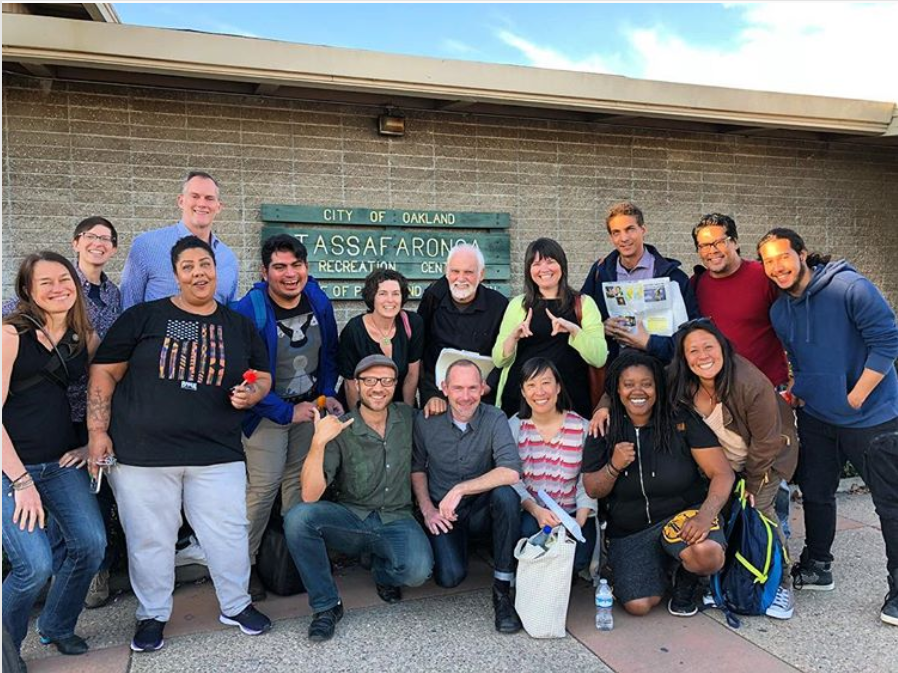At other Project Working Group meetings, the All Bay Collective used the It Together game to ask participants to identify and create priority strategies, and negotiate their interests along the way. Image: The All Bay Collective/Janette Kim.
RBD ENGAGEMENT TOOLKIT
Faculty Research
Date: Spring 2018, California College of the Arts, Architecture Division
Principal Investigator: Janette Kim
Cities that face climate change impacts need to build collaboration through community-centered collaboration. As part of our work with communities around San Leandro Bay for our project “The Estuary Commons” for the Resilient by Design Bay Area Challenge, our team, called the All Bay Collective, developed a three-part toolkit consisting of a board game, an equity checklist, and a quadruple bottom line framework.
In It Together. This fun but serious game brings stakeholders together around a map of the Estuary to cooperatively explore adaptation strategies, weigh their tradeoffs, and achieve greater local resilience. In this game, players role-play diverse stakeholders and initiate adaptation actions (such as living levees, tidal cities, and community land trusts) by placing corresponding pieces on a map of the Oakland Estuary. As the rounds advance, so too does flooding, taxing players if flood waters reach unprotected buildings or infrastructure. Players can compete (to individually accomplish their goals) or cooperate (to achieve a win-win solution by scoring ‘Collective Resilience Points’). ABC has co-created, played, and refined In It Together with agency and community representatives around San Leandro Bay. See more on In It Together here.
Community Resilience Investment Decision-Making Tool. Many cities, nationally and internationally, are using triple bottom line (TBL) approaches to measure tradeoffs between different policy options, maximize scarce resources, and realize interrelated financial, social, and environmental goals. However, TBL frameworks are less frequently used in community-driven planning or for projects that span jurisdictional boundaries. Improving on previous TBLs, our team developed the Community Resilience Investment Decision-Making Tool. This adaptable framework helps users evaluate the social, environmental, financial, and governance co-benefits of different investment choices. Working with agency and community representatives, we co-created a tailored set of criteria and indicators. These metrics elevate the importance of collaborative governance approaches and, in doing so, encourage a more equitable path forward for decision-making. Furthermore, community groups and public agencies can refine and adapt this tool as their resilience, equity, and environmental goals evolve.
Equity Checklist. The ABC Equity Checklist helps communities document and advocate for their priorities in local investment decisions, focusing on factors related to socioeconomic equity, inclusion in decision-making, and public health. To make this checklist, ABC drew on resources such as the Bay Area Regional Health Inequities Framework (built environment indicators related to health outcomes), APEN’s “Investment without Displacement” guidelines (anti-displacement and affordable housing), and the Greenlining Framework (equitable transportation investments). We also asked equity advisors from the Resilient By Design Research Advisory Committee to review and refine the checklist.
See the Connecting People to Climate Risks: Participation + Action + Education Toolkit, published by the Resilient by Design Bay Area Challenge here, and a small brochure on the All Bay Collective tools described on this page here.
Commissioning Agency: Resilient by Design All Bay Challenge.
The All Bay Collective: AECOM, CMG Landscape Architecture, CCA Urban Works Agency, and UC Berkeley, with David Baker Architects, Silvestrum, Skeo, and Moll de Monchaux.
UWA Principal Investigators: Janette Kim and Neeraj Bhatia.
Research/Design Assistants: Liz Lessig and Cesar Lopez (Resilience Fellows), Namhi Kwun and Carlos Serrano.
Partnering community-based organizations: East Oakland Collective, Oakland Climate Action Coalition, Scraper Bike Team, Merritt College Brower Dellums Institute for Sustainable Policy Studies, Planting Justice, HOPE Collaborative, East Oakland Building Health Communities, and Repaired Nations.
Partnering government organizations: Oakland Planning, the City of Alameda, BART, the Port of Oakland, East Bay Regional Park District, and EBMUD.
Credits: In It Together was created by California College of the Arts Urban Works Agency/Janette Kim and All Bay Collective for the Resilient by Design Bay Area Challenge. The game is currently under development for commercial distribution with Room and Board Games. The All Bay Collective team includes AECOM, CMG Landscape Architecture, UC Berkeley College of Environmental Design, and CCA, in association with Silverstrum Climate Associates, Skeo, Moll de Monchaux, and David Baker Architects. CCA student authors are Shahad Alamoudi, Marwan Barmasood, Georgia Came, Denisse Correa Guerra, Ally Foronda, Eric Fura, Francisco Garcia, Jessica Grinaker, Fathmath Isha, Lori Martinez, Jennifer Pandian and Sabrina Schrader.



















